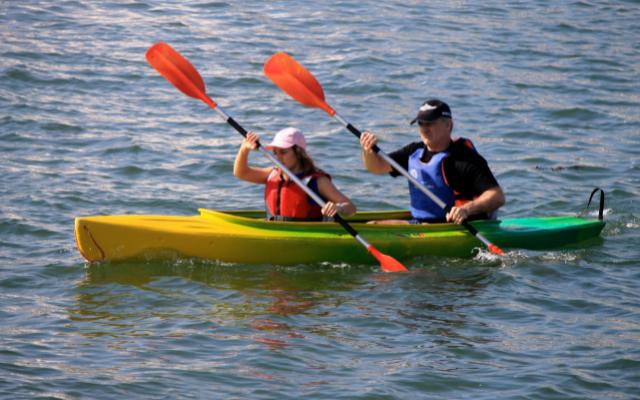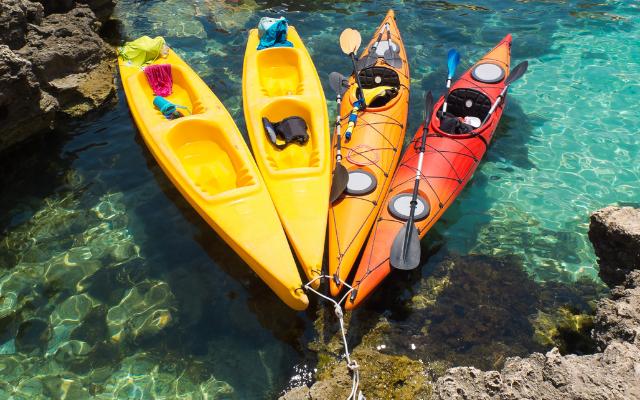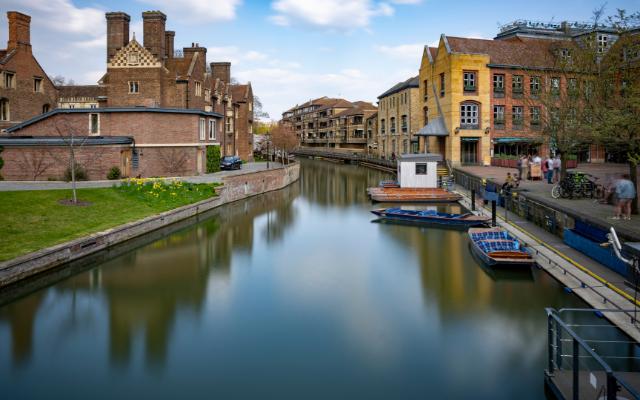Kayaking vs Canoeing: Key Differences & Similarities [Explained]
The Complete Kayaking Vs Canoeing Guide
Kayaking and Canoeing are two popular water sports that are often confused with each other and as such, Kayaking Vs Canoeing comparisons are constantly made.
Both involve paddling a small watercraft, but the differences between the two are significant.
Understanding the differences between kayaking and canoeing can help you choose the right activity for your interests and skill level.
So, in this Kayaking Vs Canoeing Guide we aim to point out, in laymans terms, the key differences of each pursuit and hopefully that’ll assist in your decision as to which you might like to have a go at.
We hope you enjoy the read. Let’s go!

Kayaking Vs Canoeing: Basic Definitions
Definition of Kayaking
Kayaking is a water sport that involves using a kayak (funnily enough) to move across water.
- A kayak is a narrow and small watercraft that is propelled using a double-bladed paddle.
- Most Kayaks have a closed cockpit where the kayaker sits with their legs stretched out in front of them.
- Kayaks are designed to be fast and manoeuvrable, making them ideal for white water rapids, sea kayaking, and touring.
- Kayaking can be done for leisure, competition, or as a means of transportation.
- Kayaking is a popular activity for adventure seekers, nature lovers, and fitness enthusiasts.
- Kayaking can be enjoyed alone or in a group, and there are different types of kayaks available for different purposes.
Kayaking Fitness Explained
Find out more about the health benefits of Kayaking here in this article entitled HOW MANY CALORIES DOES KAYAKING BURN?
Definition of Canoeing
Canoeing is a water sport that involves using a canoe (funnily enough) to move across water.
- A canoe is a wider and larger watercraft that is propelled using a single-bladed paddle.
- Canoes have an open top where the canoeist sits either on a bench or on the bottom of the boat.
- Canoes are designed to be stable and efficient, making them ideal for calm waters, lakes, and rivers.
- Canoeing can be done for leisure, competition, or as a means of transportation.
- Canoeing is a popular activity for families, couples, and groups.
- Canoeing can be enjoyed alone or in a group, and there are different types of canoes available for different purposes.
In summary, when considering Kayaking Vs Canoeing, both enjoyable water sports that offer different experiences.

Key Differences Between Kayaking and Canoeing
The Craft
One of the most significant differences between kayaking and canoeing is the type of boat used.
Kayaks are typically closed-top boats that are designed for one or two people.
They are designed to sit lower in the water than canoes, which tend to have higher sides.
In contrast, canoes are usually open-top boats that can accommodate more people and gear.
They are often used for recreational paddling, fishing, and camping trips.
The Paddle
Another main difference between kayaking and canoeing is the type of paddle used.
Kayakers use a double-bladed paddle, while canoeists use a single-bladed paddle.
The Seating
The differences in paddles is because kayakers sit in a low position with their legs stretched out in front of them, while canoeists typically kneel or sit on a raised seat with their feet flat on the bottom of the boat.
The different seating positions require different types of paddles to be used effectively.
Kayaking is generally faster and more manoeuvrable, while canoeing is generally more stable and efficient.
Both activities can be enjoyed by people of all ages and skill levels, and there are different types of equipment available for different purposes.
Kayak Vs Canoe: Design and Structure
When it comes to design and structure of Kayaks Vs Canoes there are also some key differences and in this section we’ll explore both in a bit more depth for both types of boats.
Design of a Kayak
Kayaks are sleek, narrow boats that are typically designed for one or two people.
They are often made from lightweight materials such as fibreglass, plastic, or Kevlar.
Kayaks are designed to be fast and agile, making them ideal for use in rapids or other fast-moving water.
The cockpit of a kayak is typically enclosed, with the paddler sitting low in the boat.
This design helps to keep the paddler dry and warm, and also provides greater stability.
Kayaks are propelled using a double-bladed paddle, which allows for greater control and manoeuvrability.
Design of a Canoe
Canoes are wider and more open than kayaks, and are typically designed for two or more people.
They are often made from materials such as wood, aluminium, or fibreglass.
Canoes are designed to be stable and sturdy, making them ideal for use on calm lakes and slow moving rivers.
The open design of a canoe allows for greater cargo capacity and easier entry and exit.
Canoes are propelled using a single-bladed paddle, which requires a different technique to that used in kayaking.
In summary, kayaks are sleeker, faster, and more agile than canoes, while canoes are wider, more stable, and definitely roomier.
The design of each type of boat is suited to its intended purpose, whether that be navigating rapids or exploring calm waters.

Kayak and Canoe: Paddling Techniques
Paddling in A Kayak
Kayaking involves using a double-bladed paddle to propel the kayak forward.
The paddler sits on the floor of the kayak with their legs stretched out in front of them.
To paddle, the kayaker should hold the paddle with both hands, ensuring that their hands are shoulder-width apart.
The paddler should then dip the blade of the paddle into the water, pulling it back towards their hip while rotating their torso to generate power.
The paddler should then lift the paddle out of the water and repeat the process on the other side to maintain forward momentum.
When paddling in a kayak, it is important to keep the paddle close to the kayak to ensure maximum efficiency.
The paddler should also aim to keep their strokes smooth and even to maintain a consistent speed.
A good paddling technique in kayaking involves using the large muscles in the torso to generate power, rather than relying solely on the arms.
Paddling in a Canoe
Canoeing involves using a single-bladed paddle to propel the canoe forward.
The paddler kneels on one knee in the canoe, with their other foot flat on the floor of the canoe.
To paddle, the canoeist should hold the paddle with both hands, ensuring that their hands are shoulder-width apart.
The paddler should then dip the blade of the paddle into the water, pulling it back towards their hip while rotating their torso to generate power.
The paddler should then lift the paddle out of the water and repeat the process on the other side to maintain forward momentum.
When paddling in a canoe, it is important to keep the paddle close to the canoe to ensure maximum efficiency.
The paddler should also aim to keep their strokes smooth and even to maintain a consistent speed.
A good paddling technique in canoeing involves using the large muscles in the torso to generate power, rather than relying solely on the arms.
Overall, both kayaking and canoeing require good paddling techniques to ensure maximum efficiency and speed.
By using the large muscles in the torso to generate power, paddlers can maintain a consistent speed and reduce the risk of injury.
Kayaking Vs Canoeing: Intended Use
Another of the significant differences between kayaking and canoeing is their intended use.
Use of Kayaks
Kayaks are designed for speed, agility, and maneuverability.
They are ideal for navigating through rapids, small streams, and narrow waterways.
Kayaks are also perfect for exploring the open sea, lakes, and calm rivers.
They are designed to be fast and responsive, making them perfect for racing and other competitive events.
Kayaks come in different shapes and sizes, and each type is designed for a specific purpose.
For example: Whitewater kayaks are designed for navigating through rapids, while touring kayaks are designed for long-distance paddling.
Sit-on-top kayaks are perfect for beginners and are easy to use.
Use of Canoes
Canoes are designed for stability, comfort, and storage.
They are ideal for carrying large amounts of gear and are perfect for long-distance trips.
Canoes are also perfect for fishing, bird watching, and other leisurely activities.
Canoes come in different shapes and sizes, and each type is designed for a specific purpose.
For example: recreational canoes are designed for leisurely paddling, while touring canoes are designed for long-distance paddling. Whitewater canoes are designed for navigating through rapids.
In summary, kayaks are designed for speed, agility, and maneuverability, while canoes are designed for stability, comfort, and storage.
Both paddle sports are suitable for different activities, and the choice of Kayaking Vs Canoeing for each individual really depends on the intended purpose.
Kayak Vs Canoe: Safety and Risks of Each
Kayaking and canoeing can be fun and exciting activities, but they can also be dangerous if proper safety precautions are not taken.
Both sports involve being on the water, and there are inherent risks associated with this.
In this section, we will discuss the safety considerations and risks associated with kayaking and canoeing.
Safety in Kayaking
When kayaking, safety should always be a top priority.
Kayakers should always wear a properly fitting personal flotation device (PFD) to ensure they stay afloat in the event of an accident.
It’s also important to wear appropriate clothing for the conditions, such as a wetsuit or drysuit in cold water.
Additionally, kayakers should always be aware of their surroundings and any potential hazards in the water.
Kayakers should also be aware of the risks associated with whitewater kayaking, which involves navigating rapids and other fast-moving water.
This can be a very dangerous activity, and kayakers should only attempt it if they have the necessary skills and experience.
It is also important to have a safety plan in place in case of an emergency.
Safety in Canoeing
Like kayaking, canoeing also involves certain safety considerations.
Canoeists should always wear a properly fitting PFD and appropriate clothing for the conditions.
They should also be aware of their surroundings and any potential hazards in the water.
One risk associated with canoeing is capsizing.
If a canoe capsizes, it is important to know how to perform a self-rescue or assist others in the water.
Canoeists should also be aware of the risks associated with cold water immersion, which can lead to hypothermia.
Overall, both kayaking and canoeing can be safe and enjoyable activities if proper safety precautions are taken.
It’s important to be aware of the risks associated with each activity and to take steps to mitigate those risks.
By following proper safety protocols, kayakers and canoeists can enjoy these activities while minimising the risk of injury or accidents.

Kayaking Vs Canoeing: Final Thoughts from Kayak Mad
In conclusion, while kayaking and canoeing share many similarities, there are some key differences that set them apart.
Understanding these differences can help individuals choose which activity is best suited for their interests and skill level.
We’ve obviously tried both paddling pursuits ourselves here at Kayak Mad and honestly, we love doing both.
Kayaking is generally considered to be a more high-intensity, adrenaline-fueled activity that requires quick reflexes and a good sense of balance.
On the other hand, canoeing is often seen as a more leisurely, relaxed activity that allows individuals to take in the scenery and enjoy a slower pace.
Ultimately, the choice between kayaking and canoeing comes down to personal preference and the type of experience an individual is looking for.
Both activities offer a great way to explore the great outdoors and get some exercise while doing so.
With the right equipment and training, anyone can enjoy the thrill of paddling on the water.
Stay safe, happy paddling, and thanks for reading!
Kayaking is generally easier due to its better stability and maneuverability, making it ideal for beginners seeking a smoother experience.
Yes, both kayaking and canoeing can be enjoyed by beginners without prior experience. Each offers a unique learning curve, and you can choose based on your preferences and interests.
Kayaking generally relies more on arm strength for paddle control, while canoeing may require more core and torso strength for stability.
Safety is crucial in both activities. Kayakers should learn how to do an Eskimo roll, while canoeists should practice effective capsiszng and re-entry techniques to ensure preparedness in case of accidents.
Kayaking and canoeing are both low-impact activities that can be enjoyed by seniors.
However, kayaking may be easier for seniors due to its more stable design and the use of a double-bladed paddle, which requires less upper body strength and can be less taxing on the joints.
Truthfully it might just come down to how flexible the actual senior is.
Kayaking would suit a more flexible, supple body and canoeing perhaps a more rigid inflexible body type.






